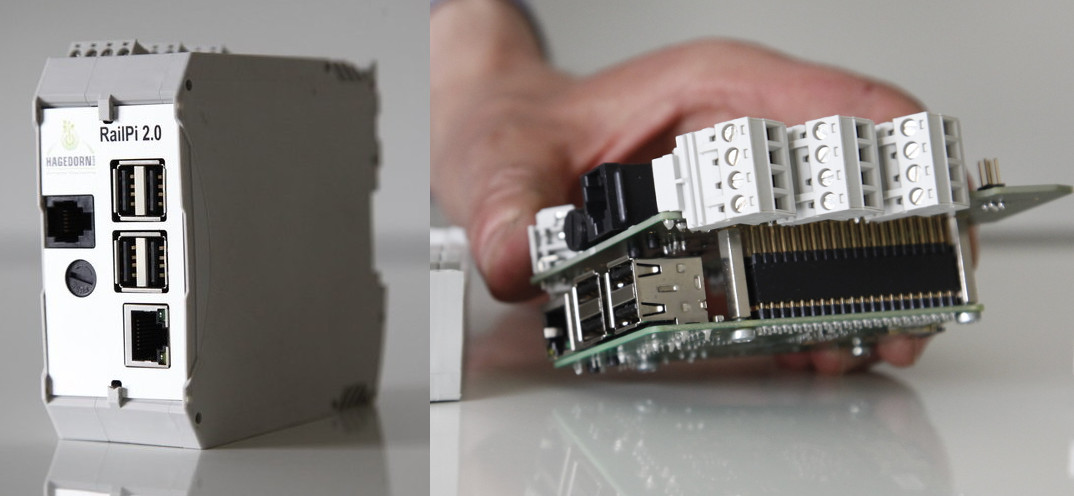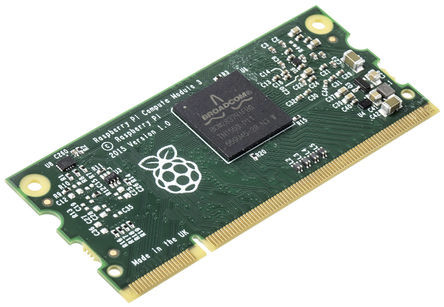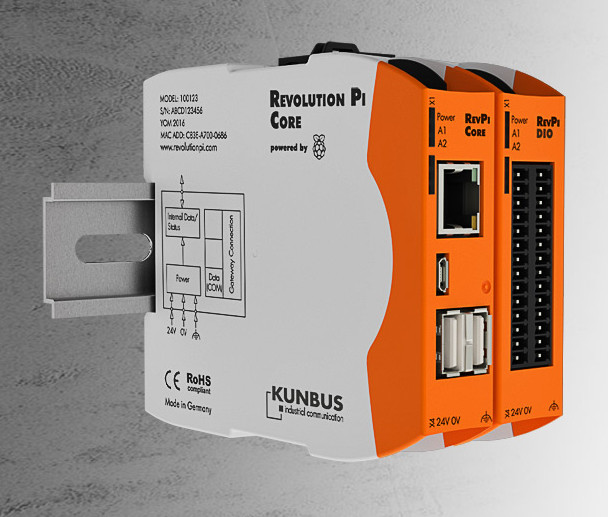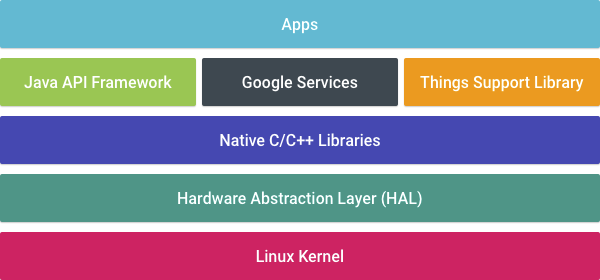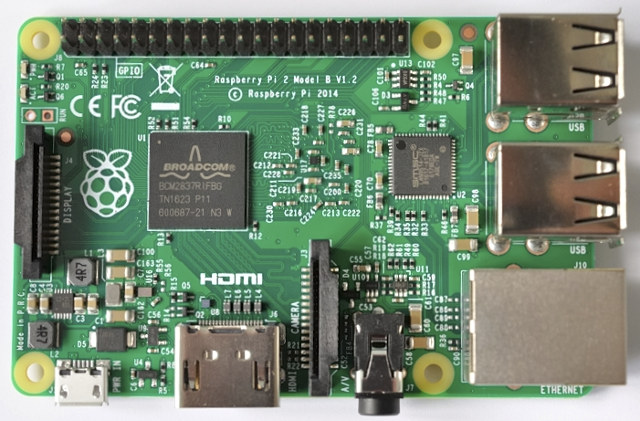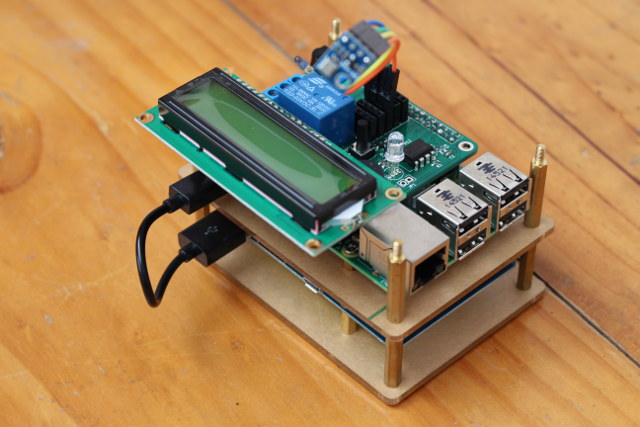We’ve already seen the Raspberry Pi compute module used for industrial applications with RevolutionPi RevPi Core industrial computer with a DIN rail enclosure, support for digital I/O modules and fieldbus gateways. Hagedorn Software Engineering GmbH, another German company has designed a similar industrial computer, called RailPi 2.0, with a DIN rail enclosure integrating an add-on board designed for Raspberry Pi 3 and ODROID-C2 boards. RailPi 2.0 specifications (adapted from Google Translation of website): I/Os 4x digital outputs, short-circuit-proof, PWM-compatible, with diode for the connection of inductive loads such as relays. 2x optically decoupled inputs, current-limited, with dimensions compliant with the S0 standard to allow them to be used with pules counters / current meters. RS485 interface 1-Wire bus placed at the front of the RailPi Bus connector for extensions with GND,I2C Clock (5V), I2C data (5V), 5V, and 12V Misc – Real-time clock Power Supply – Input voltage range of […]
Raspberry Pi 3 Compute Modules CM3 and CM3L Launched for $30 and $25
We all knew Raspberry Pi Compute Module 3 were about to be launched soon, as the Raspberry Pi foundation announced a partnership with NEC displays last October, and the datasheet for two version of the Broadcom BCM2837 based system-on-module, CM3 and CM3L (Light), was released shortly after. The good news is that the modules have officially been launched for $30 and $25 for respectively Compute Module 3 with 4GB flash, and Compute Module 3 Light with the SD card signals exposed via the SO-DIMM connector. The foundation has also lowered the original compute module price to $25. Here are Compute Module 3 specifications as a reminder: SoC – Broadcom BCM2837 quad core Cortex A53 processor @ 1.2 GHz with Videocore IV GPU System Memory – 1GB LPDDR2 Storage CM3L – SD card signals through SO-DIMM connector CM3 – 4GB eMMC flash 200-pin edge connector with: 48x GPIO 2x I2C, 2x SPI, […]
Ten Most Popular Posts of 2016 on CNX Software and Some Stats
The last day of the year is a good time to look back at what the year brought us, and I have to say it has been a fun and interesting year on CNX Software. The TV boxes news cycle has been dominated by Amlogic products, but most products have now switched to 64-bit ARM SoC, with 4K and HDMI 2.0 support, and price have kept going down, so you can now get a 4K TV box for as low as $20, although many people will prefer spending a bit more for extra memory and support. Intel based Bay Trail & Cherry Trail mini PCs have continued to be released with Windows, and in some cases Ubuntu, but the excitement seems to have died off a bit, maybe with the expectation of upcoming Apollo Lake mini PCs that should be more powerful. The year have been especially fruitful in the […]
Kunbus RevolutionPi RevPi Core Raspberry Pi based Industrial Computer Sells with Digital I/O Modules and Fieldbus Gateways
Kunbus, a German company specialized in industrial network solution, has decided to design an industrial system based on Raspberry Pi Computer module supporting variable power supply, a wide temperature range, DIN rail mounting, etc, as well as corresponding digital I/O modules and fieldbus gateways. RevolutionPI RevPi Core specifications: SoC – Broadcom BCM2835 ARM11 processor @ 700 MHz System Memory – 512 MB Storage – 4GB flash Video Output – Micro HDMI port Connectivity – 10/100M Ethernet port USB – 2x USB 2.0 host ports, 1x micro USB port Misc – RTC, 3x status LEDs (2 programmable) Power Supply – 10.7 V to 28.8 V; polarity protection; 4 kV / 8 kV ESD protection & EMI passed (according to EN61131-2 and IEC 61000-6-2), surge and burst tests passed Power Consumption – Max: 10 Watts including 2 x 450 mA USB load; typ.: 4 watts. Dimensions – 96 x 22.5 x 110.5 […]
Android Things OS for the Internet of Things Supports Raspberry Pi 3, Intel Edison, and NXP Pico Boards
Google introduced Project Brillo a little over a year ago, an operating system based on Android, but with a smaller footprint optimized for Internet of Things applications. Brillo has now just become Android Things OS, with Google releasing a developer preview of Android Things working on Raspberry Pi 3, Intel Edison, and NXP Pico boards. The company has also updated the Weave platform to simplify connection of all types of devices to the cloud, and interaction with services like the Google Assistant. The Weave Device SDK currently supports schemas for light bulbs, smart plugs, switches, and thermostats, with more type of device supported in the future, as well as a mobile app API for both Android and iOS. Using an Android based OS instead of a pure Linux OS should make it easier for Android app developers to create smart devices thanks to the use of familiar Android APIs and […]
Raspberry Pi 2 Gets an Upgrade to 64-Bit Broadcom BCM2837 Processor with PCB Version 1.2
With the launch of Raspberry Pi 3 based on Broadcom BCM2837 quad core Cortex A53 processor earlier this year, sales of Raspberry Pi 2 boards have suffering meaning the demand for Broadcom BCM2836 quad core Cortex A7 processor has also been reduced, and it appears the Raspberry Pi foundation has now launched Raspberry Pi 2 V1.2 with the faster BCM2837 processor. The new Raspberry Pi 2 v1.2 runs BCM2837 CPU cores up to 900 MHz, instead of 1.2 GHz on RPi 3, and includes 1 GB RAM. The main difference with Raspberry Pi 3 is the lack of the WiFi and Bluetooth module, which may also prevent some UART issues if you want to access the serial console or use an add-on board with UART. Since both boards cost the same ($35), most people should probably stick with Raspberry Pi 3, unless you’d rather not have any wireless module on […]
Outernet Introduces Standalone & DIY Internet Satellite Kits for C.H.I.P Board, Raspberry Pi 3 Board, and Laptops
Outernet goal is to bring knowledge and/or emergency info to places without Internet either to remote places, or where Internet has been temporary shutdown due to natural disasters or political reasons through a satellite feed. In some ways, it works like a typical FM radio, but instead of receiving audio, you’ll get data. The first hardware was based on WeTek Play TV box, and called Lighthouse, but they now have a DIY kit that will work with Next Thing C.H.I.P, Raspberry Pi, or Laptops running Windows 7/10 or Linux, as well as a standalone Outernet Satellite kit including C.H.I.P Allwinner R8 development board. Let’s first check out “Basic Outernet DIY Kit” comprised of three items: L-Band Antenna Frequency: 1525 – 1559 MHz (Center frequency: 1542 MHz) 8dbi 4″ SMA Male connector Dimensions – 12 cm x 12 cm x 1.5 cm Weight – ~100 grams RTL-SDR Blog Software Defined Radio/Tuner […]
RabbitMax Flex IoT Board for Raspberry Pi Supporting up to Five I2C Sensors Launched on Indiegogo for 20 Euros and Up
RabbitMax Flex is an add-on board, compatible with HAT specifications, for Raspberry Pi 2 /3 boards and other Raspberry Pi models with a 40-pin GPIO header. It includes headers for up to 5 I2C sensors, as well as an RGB LED, a buzzer, a relay, a button, infrared receiver and transmitter, and an optional LCD display, and as we’ve seen in my RabbitMax Flex getting started guide, a nice way to learning about hardware programming using either C or Python, or to used in home automation or IoT projects. The project has just been launched on Indiegogo. RabbitMax Flex specifications: Relay – Songle SRD-05VDC-SL-C supporting 125V/250VAC up to 10A, 30VDC up to 10A Storage – EEPROM with some system information for identification IR – IR LED, IR receiver Misc – Buzzer, Button, RGB LED Expansion Header for LCD character display + potentiometer for backlight adjustment 5x 4-pin headers for I2C […]


